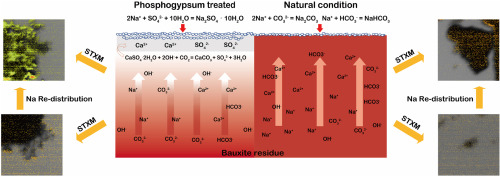Journal of Cleaner Production ( IF 11.1 ) Pub Date : 2020-03-26 , DOI: 10.1016/j.jclepro.2020.121266 Yujun Wu , Meng Li , Ding Fu , Talitha C. Santini , Jun Jiang , William Hartley , Shengguo Xue

|
Bauxite residue is a solid, highly alkaline byproduct generated in the alumina refining process. The process that forms the fine white salt deposits on the surface of bauxite residue disposal areas (BRDAs) following prolonged dry periods, and which also forms on products made from reused residues (sintered bricks, etc.), is known as efflorescence. It not only seriously affects the utilization of bauxite residue in building materials, but also creates potential dust pollution around the BRDAs, which means it would require sustained and intensive resources to manage and transform its alkalinity. Through a laboratory simulation experiment using soil leaching columns, we show that the extent of bauxite residue efflorescence is affected by many factors, including porosity, initial water content, bauxite residue particle size. The main soluble mineral precipitates of efflorescence are Na2CO3 and NaHCO3. Addition of phosphogypsum, a common amendment to reduce dispersion and promote removal of Na+ through leaching, shifted the composition of effloresced salts to favor Na2SO4·10H2O. SEM and Na K-edge X-ray absorption near-edge structure (XANES)spectroscopy demonstrated that free alkali migrates to the residue surface to precipitate as a uniform agglomerate in the efflorescence process, which also changes the chemical form of Na-containing minerals in the bauxite residue and the mesoscale spatial distribution of Na (soft X-ray scanning transmission microscopy imaging). Free alkali migration with water is the main driver of efflorescence, and this work also demonstrated that phosphogypsum can reduce the generation of alkaline efflorescence for ameliorating alkaline dust pollution from bauxite residue.
中文翻译:

添加磷石膏后铝土矿渣处置区碱性风化形成的模拟研究
铝土矿残留物是氧化铝精炼过程中产生的固体,高碱性副产物。长时间干燥后,在铝土矿残渣处置区(BRDA)的表面上形成细小的白色盐沉积物的过程,以及在由重复使用的残渣(烧结砖等)制成的产品上形成的过程,也被称为风化。它不仅严重影响建筑材料中铝土矿残留物的利用,而且还会在BRDA周围产生潜在的粉尘污染,这意味着需要持续不断的资源来管理和转化其碱度。通过使用土壤浸出柱的实验室模拟实验,我们显示铝土矿渣的风化程度受许多因素影响,包括孔隙率,初始含水量,铝土矿渣的粒径。2 CO 3和NaHCO 3。磷石膏的添加是减少分散并通过浸出促进Na +去除的常见修正,改变了风化盐的成分,从而有利于Na 2 SO 4 ·10H 2。O. SEM和Na K边缘X射线吸收近边缘结构(XANES)光谱表明,游离碱迁移至残留表面,在风化过程中以均匀的团聚体形式沉淀,这也改变了含Na的化学形式铝土矿残渣中的矿物和Na的中尺度空间分布(软X射线扫描透射显微镜成像)。水中的游离碱迁移是风化的主要驱动力,这项工作还证明了磷石膏可以减少碱风化的产生,从而减轻铝土矿残留物中的碱性粉尘污染。


























 京公网安备 11010802027423号
京公网安备 11010802027423号